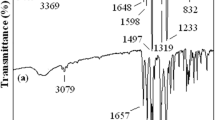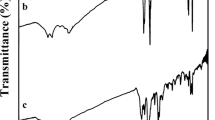Abstract
A new dicarboxylic acid monomer containing the N-methylcarbazole and imide structures, 3,6-bis(trimellitimido)-N-methylcarbazole (I), was prepared from the condensation of 3,6-diamino-N-methylcarbazole (c) and trimellitic anhydride. The diamine c was synthesized in three steps starting from the methylation of carbazole, followed by nitration and catalytic hydrazine reduction. A series of N-methylcarbazole-containing poly(amide–imide)s were synthesized by direct polycondensation from the diimide–diacid I with various aromatic diamines. These poly(amide–imide)s had inherent viscosities of 0.66–1.47 dl/g and were readily soluble in a variety of organic solvents, including N-methyl-2-pyrrolidone and N,N-dimethylacetamide (DMAc). Transparent, flexible, and tough films of these polymers could be cast from DMAc solutions, and these films exhibited excellent mechanical strength. The glass-transition temperatures of these poly(amide–imide)s were in the range 317–362 °C. All the poly (amide–imide) did not degrade noticeably below 480 °C in nitrogen, and the 10% weight loss temperatures and char yields at 800 °C were above 520 °C and 60% in nitrogen, respectively, indicating high thermal stability.
Similar content being viewed by others
Author information
Authors and Affiliations
Additional information
Received: 8 February 2000/Accepted: 23 March 2000
Rights and permissions
About this article
Cite this article
Yang, CP., Chen, RS. & Chang, CC. Synthesis and properties of poly(amide–imide)s containing a N-methylcarbazole group. Colloid Polym Sci 278, 1043–1051 (2000). https://doi.org/10.1007/s003960000352
Issue Date:
DOI: https://doi.org/10.1007/s003960000352




